Menu
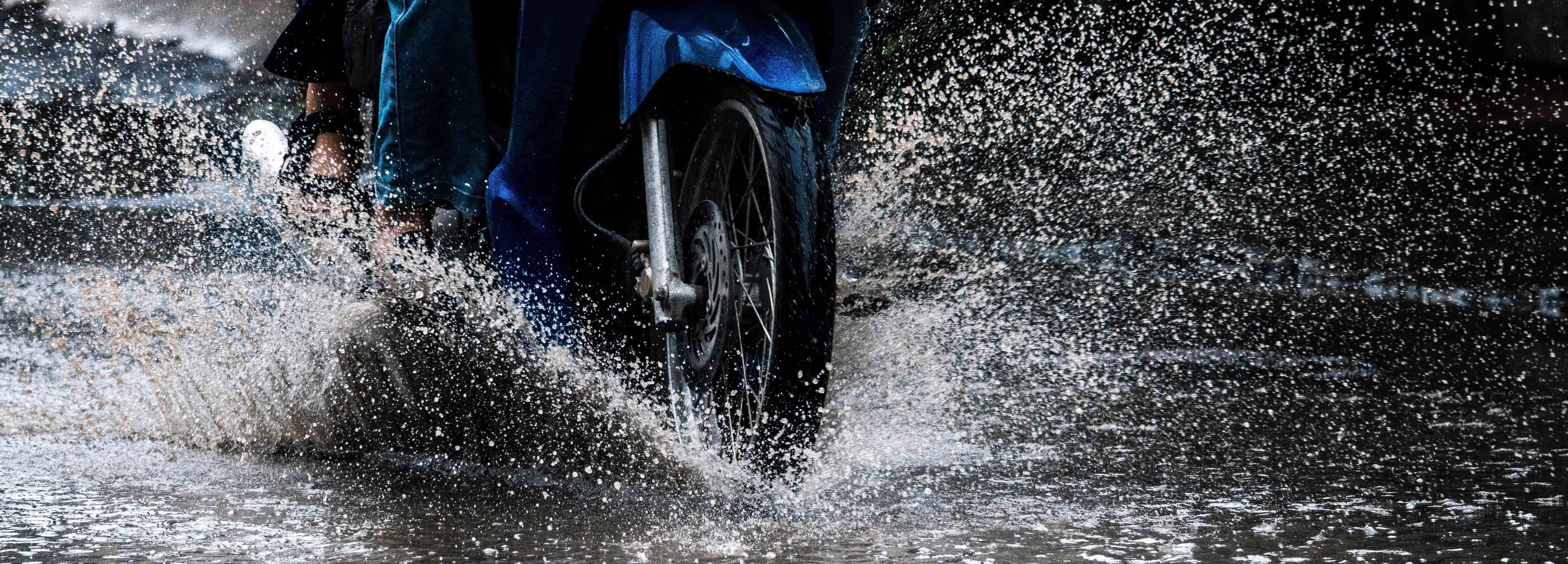
Can You Ride a Motorcycle in The Rain?
Can You Ride a Motorcycle in The Rain?
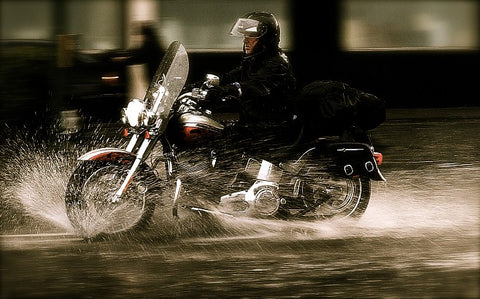
Riding a motorcycle in the rain can be an exhilarating experience, but it's important to prioritize safety, especially when riding on wet roads. Wet conditions can significantly increase the risk of accidents due to reduced traction and visibility. In this blog, we will discuss the essential tips and techniques for safely riding a motorcycle on wet roads, as well as providing specific advice for both men and women riders.
Motorcycle Riding Gear
Before hitting the road, it's crucial to ensure you have the appropriate safety gear. This includes a DOT-approved helmet, eye protection, gloves, armored jacket, pants, and boots. In wet conditions, consider wearing gear that is waterproof and provides good insulation to keep you warm. Visibility is also key, so choose gear with reflective material or bright colors to ensure you are easily seen by other motorists.
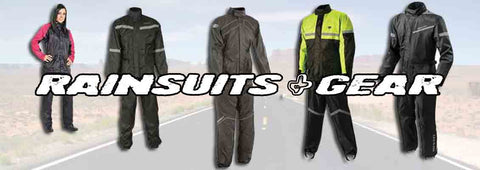
Rain Gear
Investing in quality rain gear is essential for riding in wet conditions. A waterproof suit or jacket and pants can help keep you dry and comfortable throughout your ride. Make sure your rain gear is breathable to prevent moisture from building up inside. Additionally, consider carrying a spare set of rain gear in case you get caught in a sudden downpour.
Motorcycle Tire Maintenance
Proper tire maintenance is crucial for safe riding, especially on wet roads. Before riding in wet conditions, check your tires for adequate tread depth and proper inflation. Worn-out tires with low tread depth can increase the risk of hydroplaning, where your tires lose contact with the road surface. Make sure your tires are in good condition, and consider switching to tires specifically designed for wet weather for enhanced grip and stability.
Brake Technique
In wet conditions, it's essential to adjust your braking technique to ensure optimal safety. Use gentle, progressive braking to avoid skidding or losing control of your motorcycle. Apply both the front and rear brakes simultaneously, but remember that most of the braking power is in the front brake. Practice emergency braking in a safe environment to develop muscle memory and improve your reaction time in case of sudden stops.
Cornering
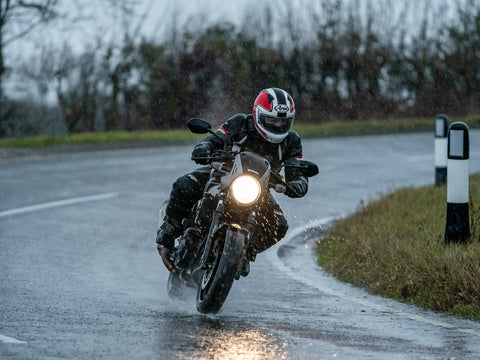
Cornering on wet roads requires extra caution and skill. Slow down before entering a turn, and choose an appropriate line that allows for a smooth exit. Avoid abrupt throttle or brake inputs mid-corner, as this can cause your tires to lose traction. Lean your body and motorcycle gradually into the turn, and maintain a steady speed throughout. Remember to look ahead and anticipate any potential hazards or changes in road conditions.
Road Position

Choosing the right road position can significantly impact your safety while riding in wet conditions. Stay away from the center of the lane, as this is where oil, debris, and water tend to accumulate. Instead, ride in the tire tracks left by cars, as this area typically offers better traction. Be mindful of painted road markings, metal grates, and other slippery surfaces that can be hazardous in wet weather.
Visibility
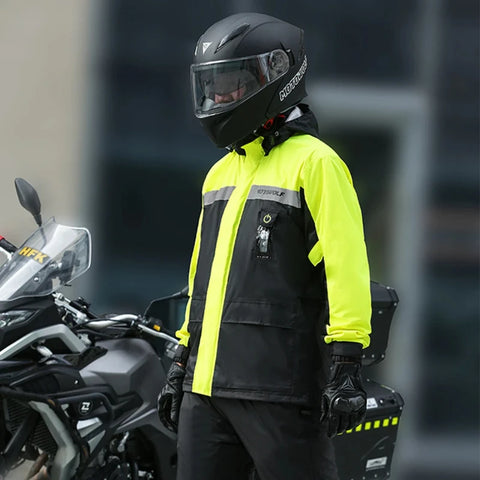
Visibility is crucial for safe riding, especially in adverse weather conditions. Make yourself as visible as possible to other motorists by using your headlights, wearing bright-colored gear, and using reflective tape or stickers on your motorcycle. Keep your visor or goggles clean and fog-free to maintain clear vision. Consider installing additional lighting on your motorcycle for increased visibility, such as auxiliary lights or LED strips.
Riding in a Group
If you're riding in a group, it's essential to communicate and ride cooperatively to ensure everyone's safety, particularly in wet conditions. Maintain a safe following distance between motorcycles to allow for adequate stopping time. Use hand signals or intercom systems to communicate with other riders about road hazards, turns, or stops. Develop a plan in case of separation or emergencies, and designate a ride leader and sweep rider to maintain order.
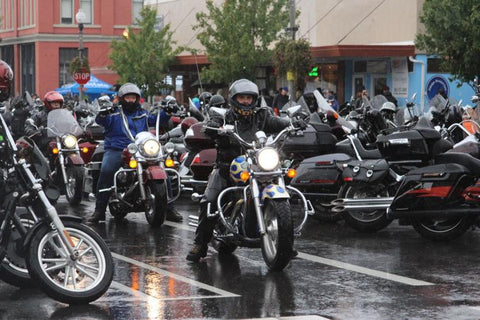
Special Tips for Men Riders:
Male riders may benefit from the following additional tips for safely riding on wet roads:
1. Be aware of your surroundings and anticipate the actions of other road users. Stay focused and avoid distractions, such as using your phone or adjusting your music while riding.
2. Practice proper throttle control to prevent skidding or losing traction in wet conditions. Smoothly apply and release the throttle to maintain stability and control of your motorcycle.
3. Stay hydrated and take regular breaks to rest and refuel during long rides. Fatigue can impair your reaction time and decision-making abilities, so listen to your body and know when to take a break.
4. Stay informed about weather forecasts and road conditions before embarking on a ride. Be prepared to adjust your route or schedule based on changing weather patterns to ensure a safe and enjoyable ride.
Special Tips for Women Riders:

Female riders may find the following additional tips helpful for riding safely on wet roads:
1. Choose gear that fits properly and provides adequate protection without compromising comfort. Look for women-specific motorcycle gear designed to accommodate a female body shape and provide optimal safety and performance.
2. Practice proper body positioning and weight distribution while cornering to maintain control and stability on wet roads. Keep your posture relaxed and centered, and use your legs and core muscles to support your body during turns.
3. Join a women's riding group or attend women-centric motorcycle events to connect with like-minded riders and share experiences and safety tips. Building a supportive network can enhance your riding skills and confidence on the road.
4. Invest in advanced rider training courses specifically tailored for women riders to enhance your skills and knowledge of riding techniques, safety practices, and motorcycle maintenance. Continuous learning and improvement are key to becoming a proficient and confident rider.
In conclusion:
Riding a motorcycle on wet roads requires heightened caution, skill, and preparation to ensure your safety and that of others on the road. By following the tips and techniques outlined in this blog, you can minimize the risks associated with riding in wet conditions and enjoy a smooth and secure riding experience. Remember to always prioritize safety, stay informed about weather conditions, and practice good riding habits to protect yourself and fully appreciate the thrill of motorcycling.
Ride Safe!
- Choosing a selection results in a full page refresh.

3 comments
Jay
Good advice but I think lacks enough emphasis on wet metal and painted road surfaces. These are only mentioned briefly and you offer no advice on how to traverse them. Slow, keep the bike upright as possible and turn or brake very gradually. Treat these surfaces like sand or gravel.
Robert Cossette
Instructif et bien écrit
Ron Perdue
I ride year round in all weather and each I’d individual storm has its challenges. Tho I raise slow during storms. Visibility is important but times no matter what ppl just don’t pay attention
Put the phones down and watch out for motorcycles more during months between July to match